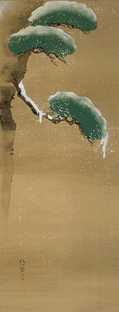 |
 |
 |
|---|
Snow [setsu] is, of course, a symbol of winter, a white covering that blankets all that is visible in other seasons. At the same time, however, a snowscape, though seemingly devoid of everything, in fact offers a hint of new life, whether it be a single plum blossom coming into bud or a tiny blade of new grass -- harbingers of a scene that is soon to unfold.
Snow is a favored backdrop in Japanese drama, especially Noh theater and Kabuki. Employing a snowy landscape heightens the tension of the story through its inherent, vivid contrast: the contrast between a completely white snow cover that buries all life and creates a frigid world of death, and the stalwart portrayal of life in the face of, and even overcoming, death. Whereas flowers and fall foliage, by their very existence, reveal the life force of nature, snow serves as a symbol of the world of winter, darkness, and death and as a foreshadowing of life to come.
What then does the moon [getsu] , ever present in the night sky, represent? In Japanese culture, the moon is more than simply a heavenly body or a scenic prop. Since ancient times the Japanese have believed that the moon is the abode of the god of moon viewing, while in Buddhism it is seen as a symbol of the truth of Buddhist law. The latter belief originates from the fact that the moon always remains in the sky, no matter how much a person might move about, walk from place to place, or even travel across the world.
Although the moon is but a single entity, it reveals itself again and again, in perfect form, everywhere. As a reflection it can appear in a solitary drop of water in the palm of one's hand or in a droplet of dew on a blade of grass. Yet, despite this seeming power to divide and multiply, the moon itself is constant, something that never leaves us. And because it always remains in the sky, though ever waxing and waning, the moon represents the fundamental truths of the universe that are known and shared by all living beings.
Japanese Art and the Japanese View of Nature by Isamu Kurita





